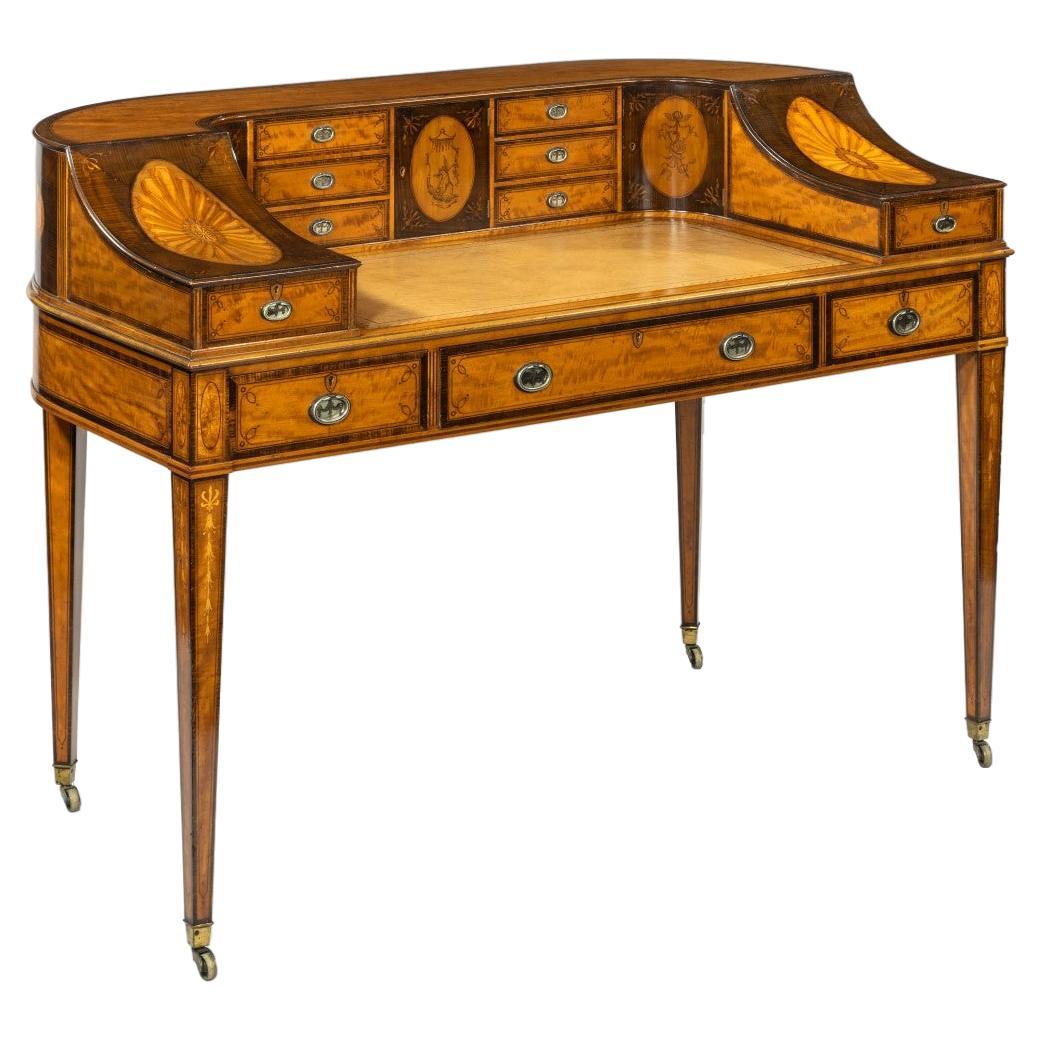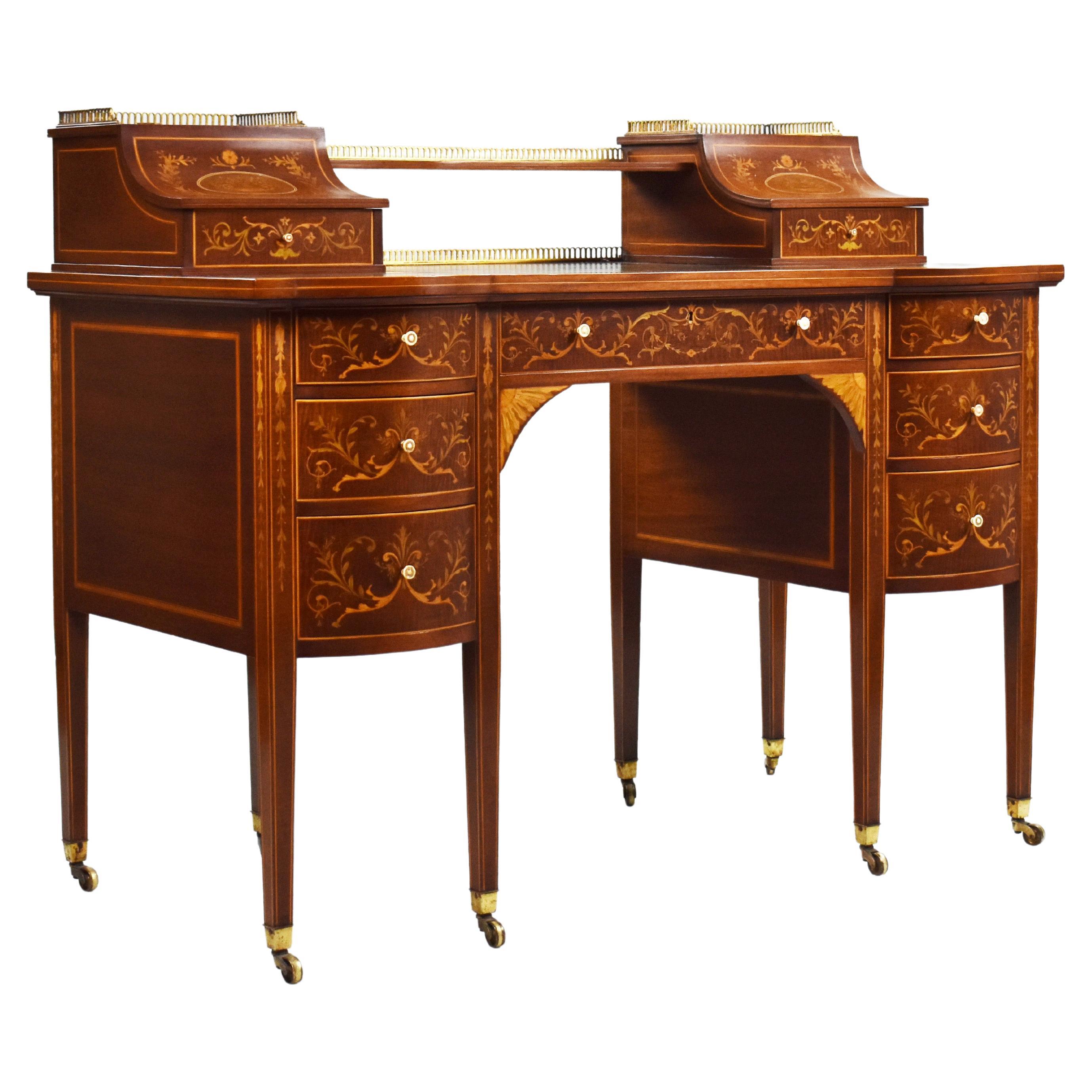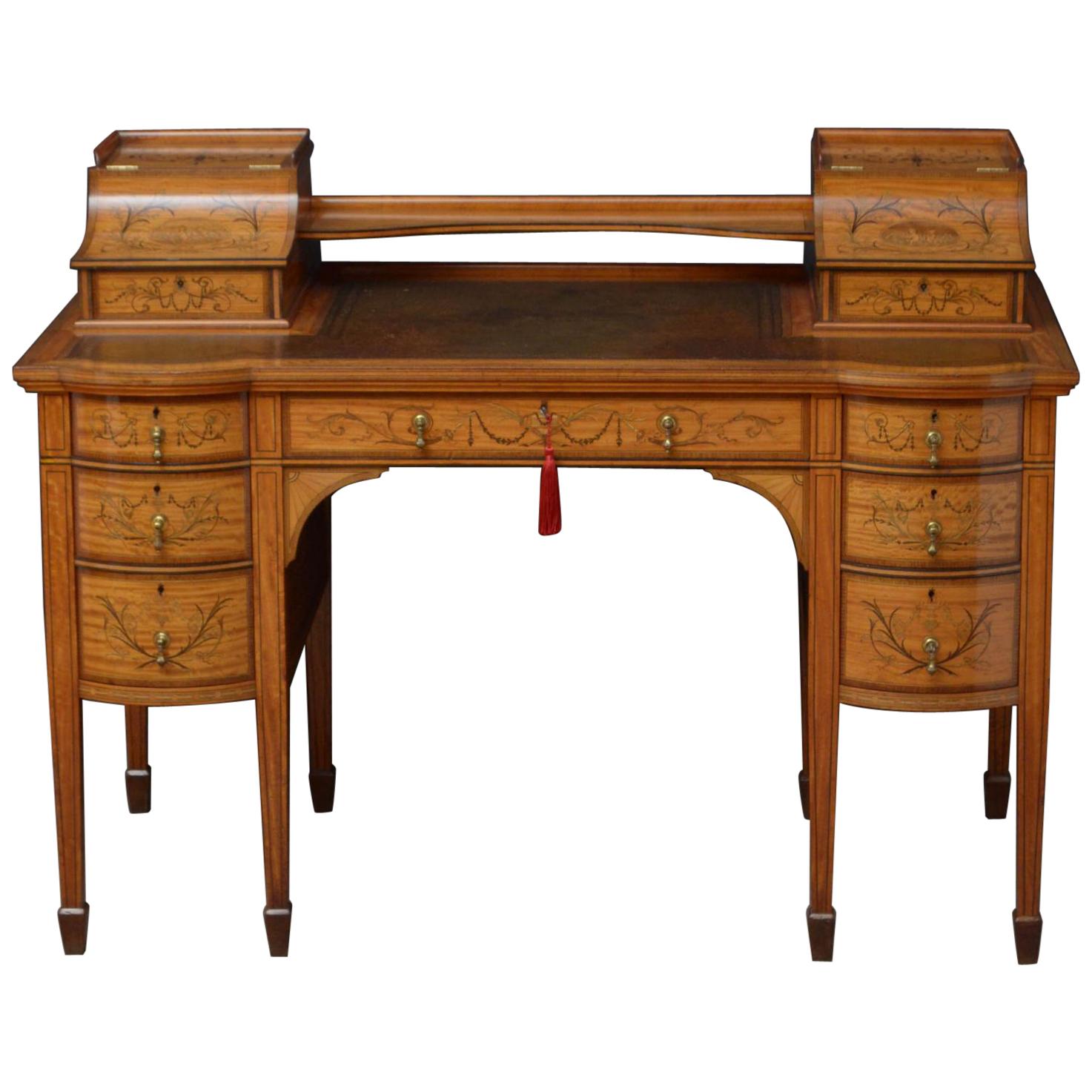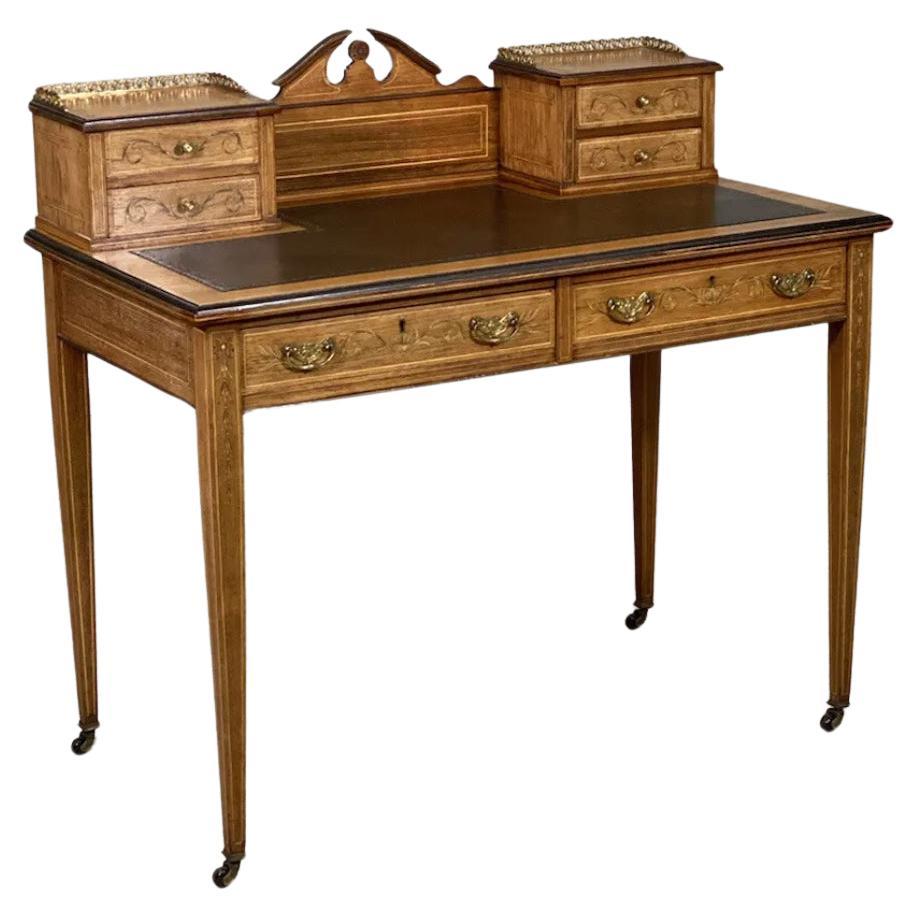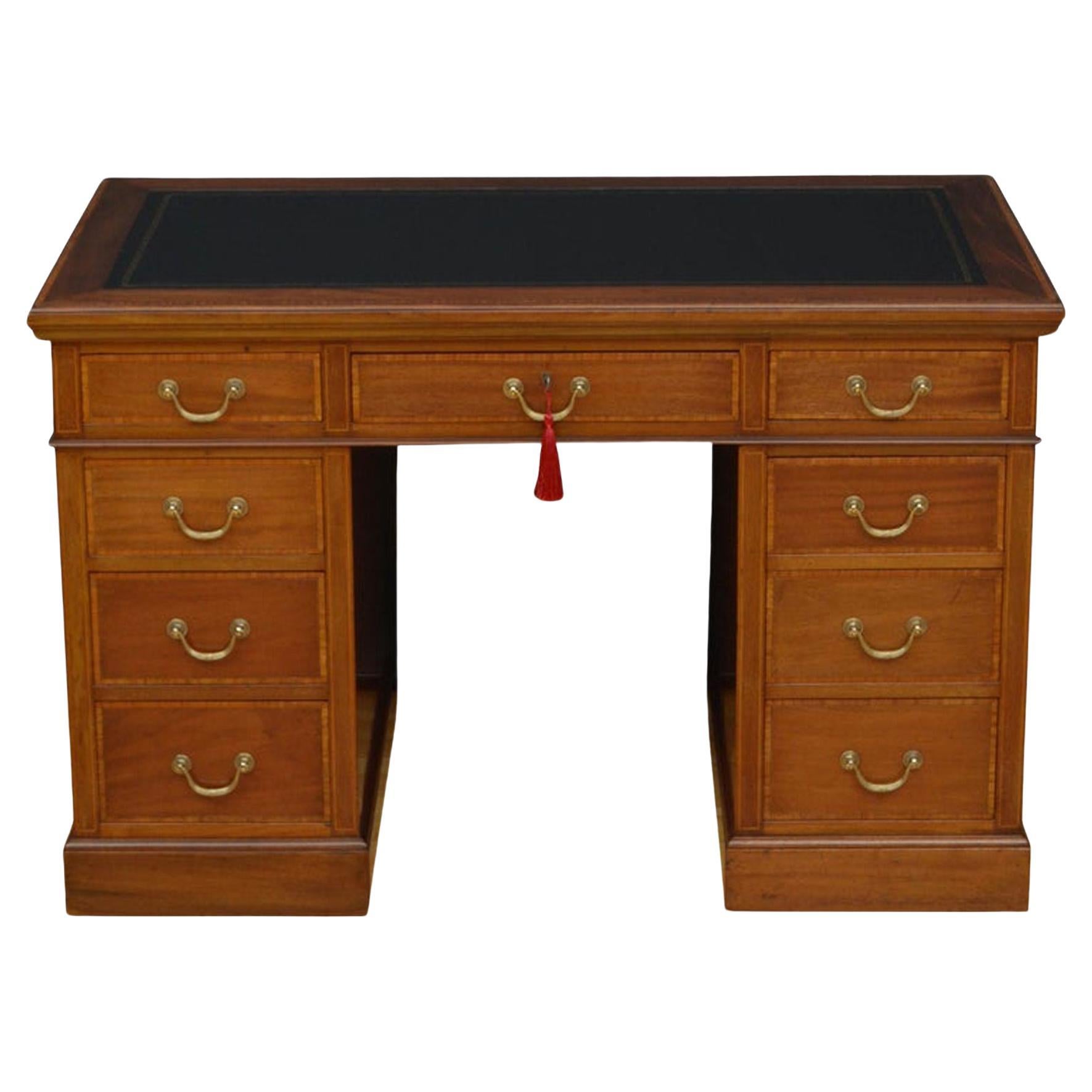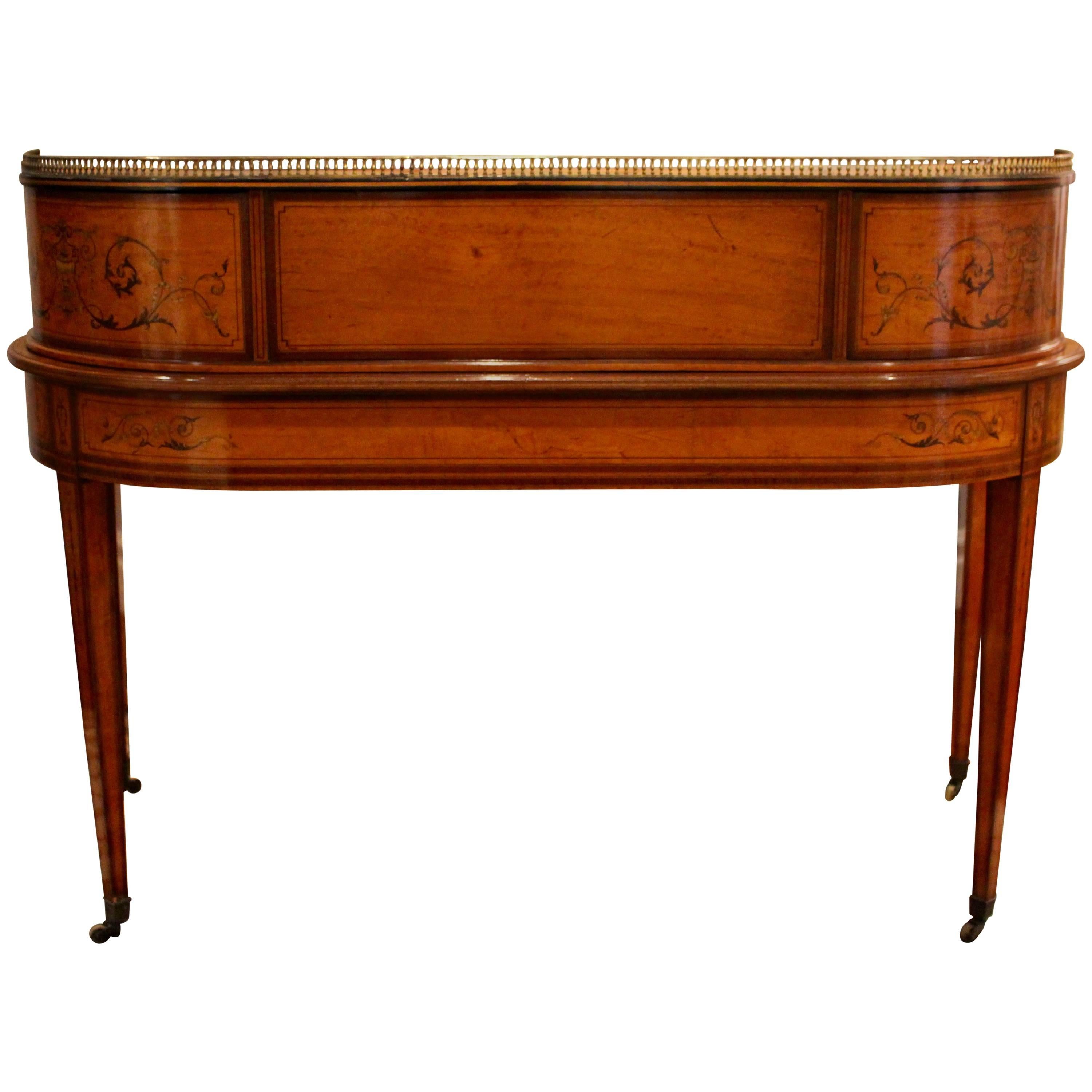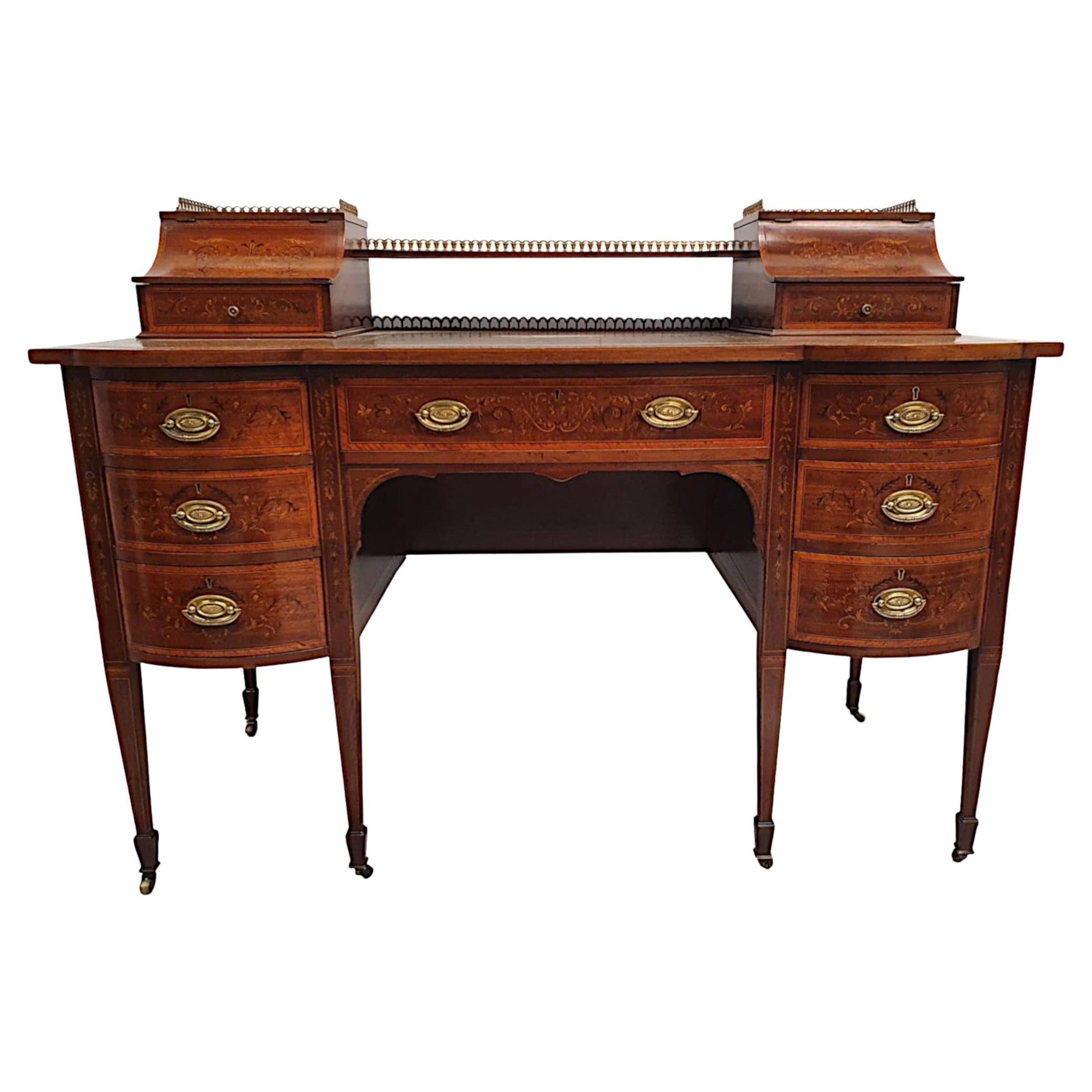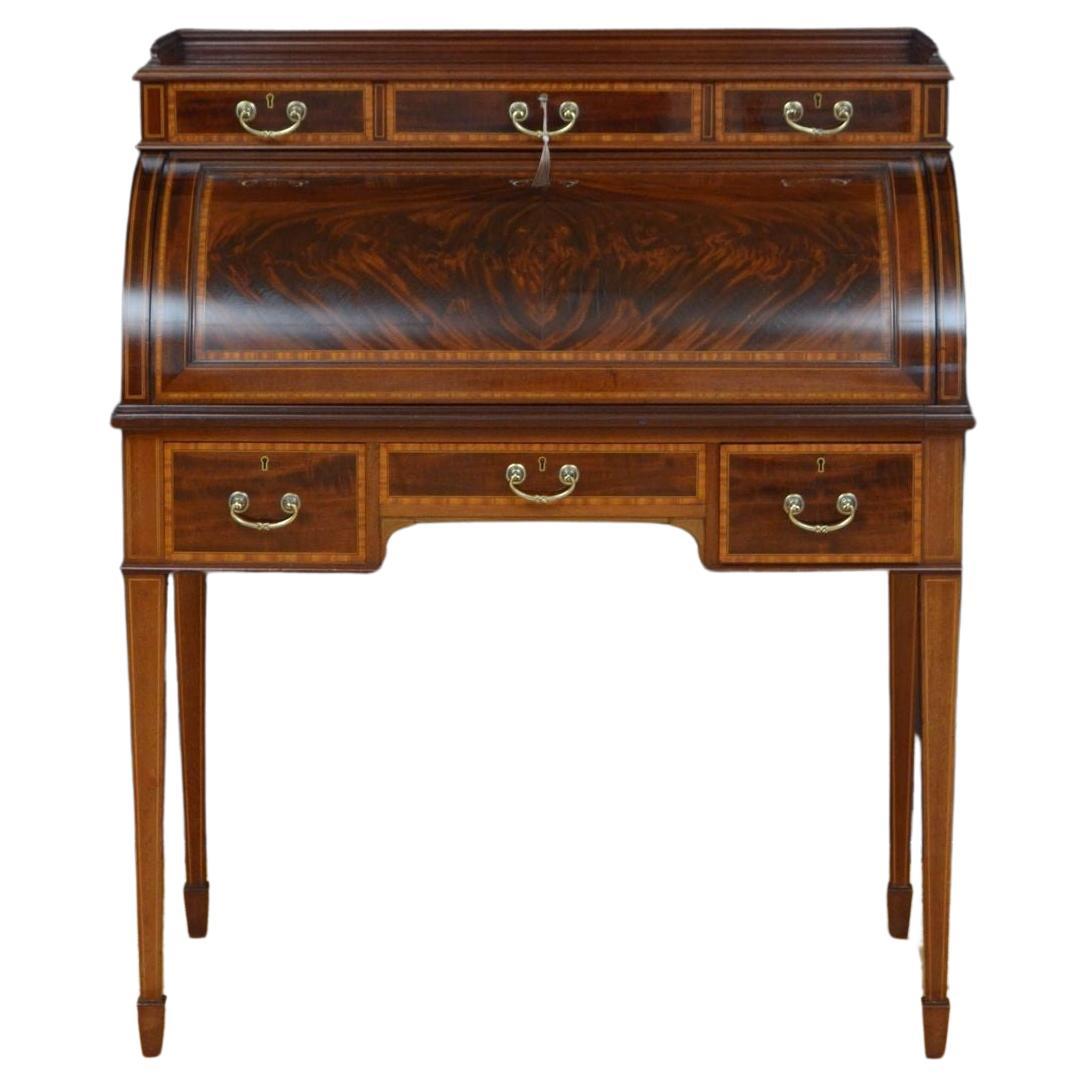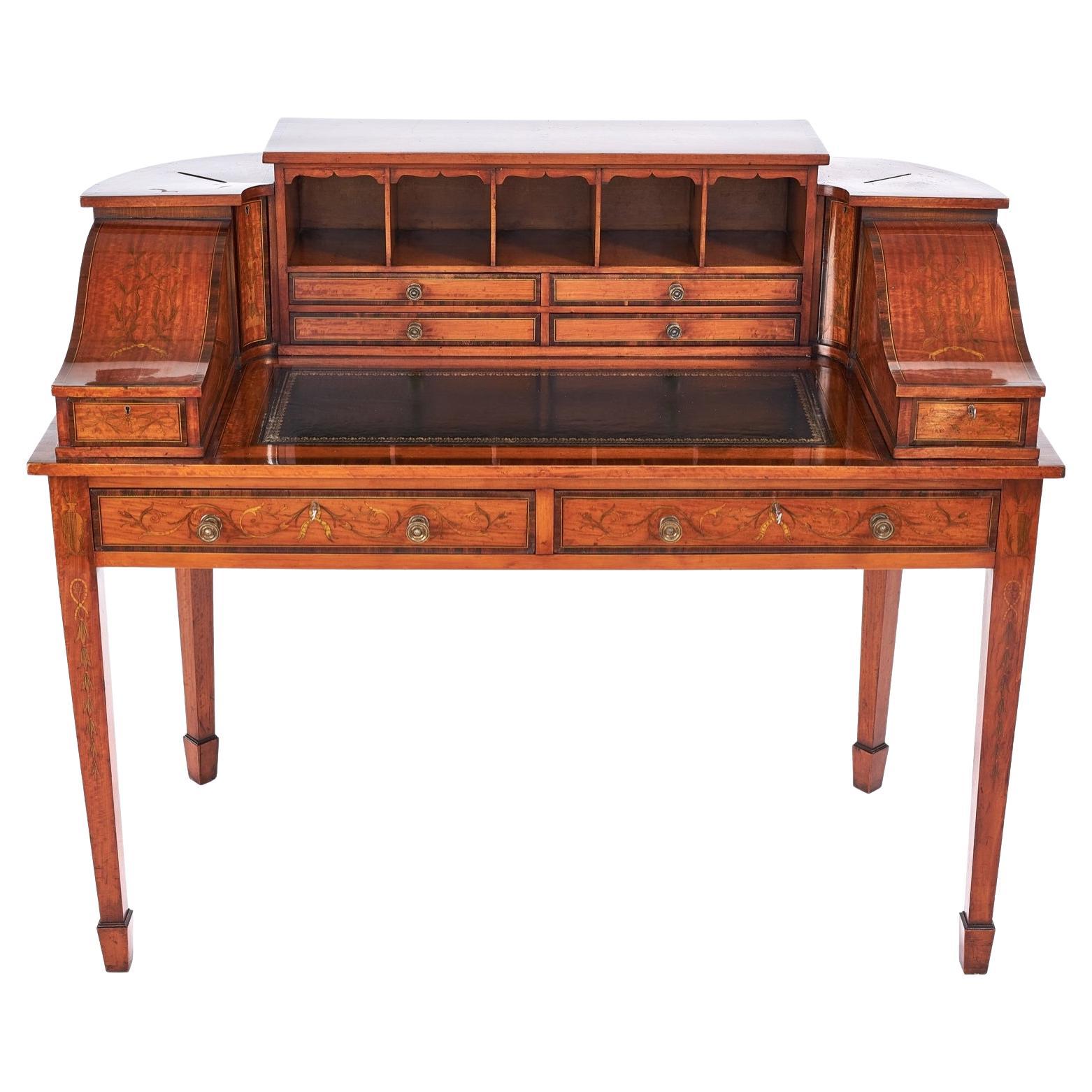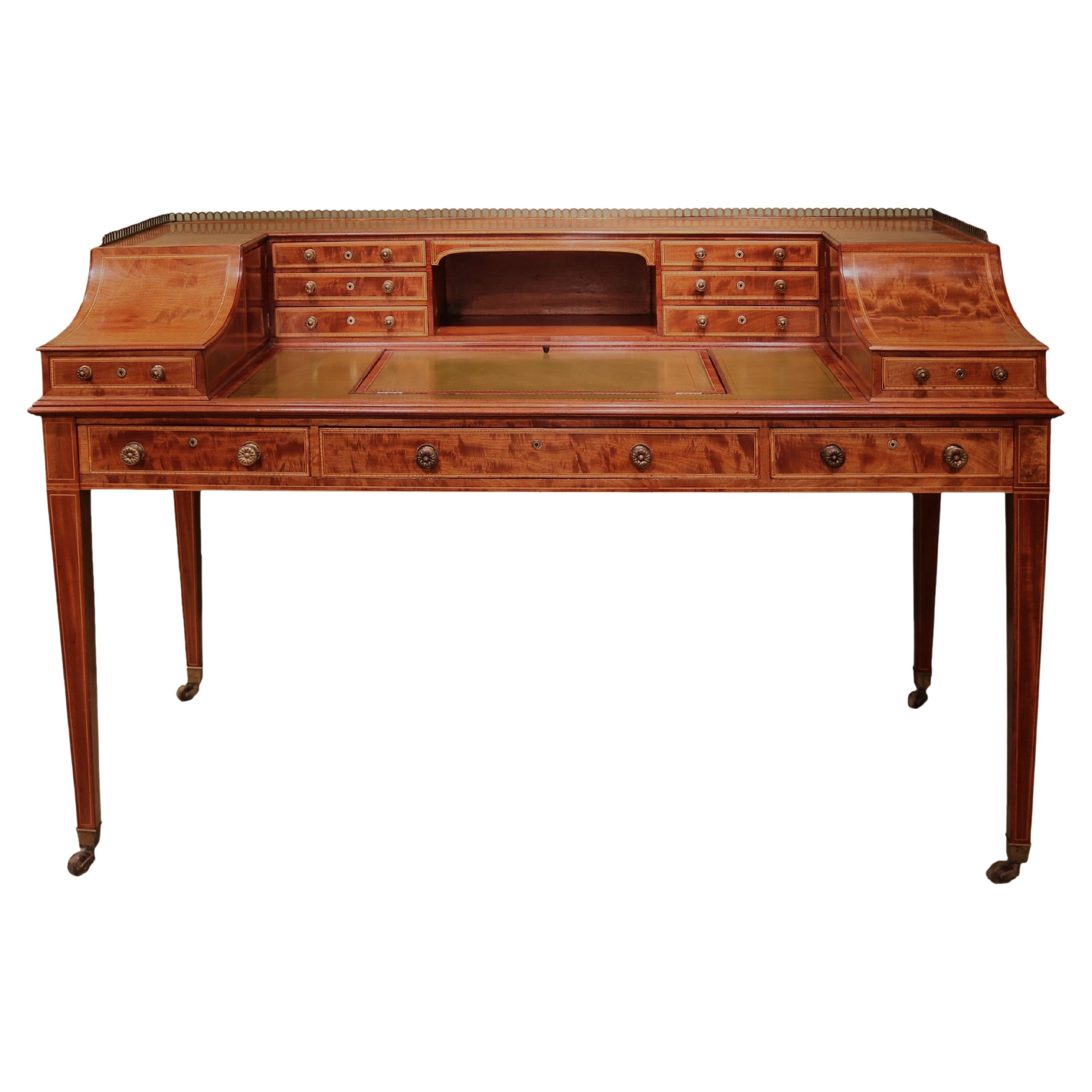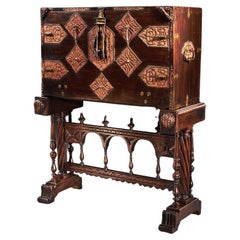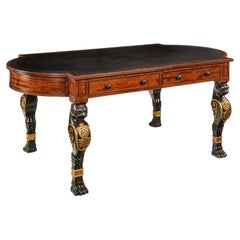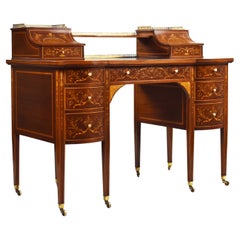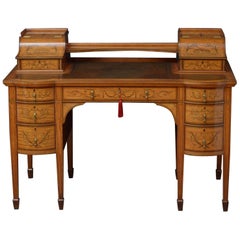
Maple & Co. Mahogany Satinwood and Marquetry Inlaid Victorian Carlton House Desk
View Similar Items
Want more images or videos?
Request additional images or videos from the seller
1 of 20
Maple & Co. Mahogany Satinwood and Marquetry Inlaid Victorian Carlton House Desk
About the Item
- Creator:Maple & Co. (Cabinetmaker)
- Dimensions:Height: 39.18 in (99.5 cm)Width: 53.35 in (135.5 cm)Depth: 26.38 in (67 cm)
- Style:Victorian (Of the Period)
- Materials and Techniques:
- Place of Origin:
- Period:
- Date of Manufacture:1880
- Condition:Wear consistent with age and use. As an antique this is in excellent condition.
- Seller Location:Benington, GB
- Reference Number:Seller: 26201stDibs: LU1183214292471
About the Seller
5.0
Vetted Seller
These experienced sellers undergo a comprehensive evaluation by our team of in-house experts.
Established in 1969
1stDibs seller since 2015
112 sales on 1stDibs
Associations
LAPADA - The Association of Arts & Antiques DealersThe British Antique Dealers' Association
More From This SellerView All
- Antique Mahogany Davenport Writing DeskLocated in Benington, HertsThis attractive mahogany Edwardian Davenport / writing desk, circa 1900s has been constructed from quality solid mahogany having a raised back above a fall front moulded edge writing slope with a raised and fielded panelled cupboard door standing on bracket feet. The Davenport's top section has a brass hinged mahogany lift up lid to reveal an original lead lined storage...Category
Antique Early 1900s English Edwardian Desks
MaterialsMahogany
- Exceptional Early 17th Century Spanish Walnut Vargueno Desk on StandLocated in Benington, HertsAn exceptionally fine example of an early 17th Century Spanish renaissance walnut vargueno / bargueno escritorio writing desk on trestle stand. Sp...Category
Antique 17th Century Spanish Renaissance Desks and Writing Tables
MaterialsWalnut
- Important Regency Mahogany Partners Writing Table in the Manner of George SmithBy George Smith, Charles NormanLocated in Benington, HertsA highly Important, Early Regency period mahogany, ebonised and parcel-gilt partners writing table on monopodia legs of exceptional quality and design, in the manner of George Smith, stamped Chas Norman, whom was associated with the work of Gillows. Labelled ‘Morning Room’. English, Regency period, circa 1810. Rarely seen, the crescent shaped ended rectangular top, beautifully lined with the original gilt tooled leather writing surface, enclosed by a mahogany cross-banded border and reeded edge. The frieze, containing four finely chosen fiddle-back mahogany drawers, two pairs to opposing sides, each retaining the original gadrooned carved ebonised knob handles. The perimeters having a finely ebonised cockbead, whilst the drawer liners being executed in mahogany retain the original recessed brass locks, which look to have never been removed. Flanking the drawers are bead-moulded ebonised panels which conform to either end above a reeded mould. Raised on four boldly designed and imposing, crisply carved, ebonised and parcel-gilt leopard monopodia supports, of wonderful original waxed condition. The Egyptian leopards mask above a bold breast decorated with carved gilt anthemion and guilloche motifs, finishing on a finely detailed carved leg and paw foot. The condition is excellent, retaining the original hand-dyed and gilt tooled waxed leather writing surface along with original locks, handles and ebonising with gilt-work to the legs. Commissioned for what presumes to be a private collection and due to its condition, being obvious to see, this writing table has been home to an important household. Labelled ‘Morning Library’ to the underside, whilst in this exemplary condition strongly suggests this striking piece of Regency furniture has furnished the library of the said house for the majority of its life. As can be noted, this is an extremely rare, elegant, early Regency writing table of exceptional colour, which corresponds with designs of the celebrated furniture maker and designer George Smith, workmanship of Gillows, being stamped to the underside Chas Norman four times. George Smith (1756 - 1826) was one of the most influential furniture designers of the English Regency Period (1811-1830). Smith, who began his pattern-book in 1804, wrote of ‘the great taste and elegance’ of this design. In 1808 he published his influential and definitive text on Regency interior Design titled ‘ A Collection of Designs for Household Furniture and Interior Decoration’ and classed himself as ‘Upholder Extraordinary to His Royal Excellency the Prince of Wales’…The Prince Regent. Smith was inspired in his designs from his earlier career as an Egyptologist, producing drawings incorporating motifs of Leopards heads and paws, Lions, sphinx’s, anthemia, and griffons amongst others. Charles Heathcote Tatham (1772-1842) published ‘Etchings, Representing the Best Examples of Ancient Ornamental Architecture; Drawn from the Originals in Rome, and Other Parts of Italy During the Years 1794, 1795, and 1796’, in which he illustrated an antique tripod table...Category
Antique 1810s British Regency Desks and Writing Tables
MaterialsMahogany, Giltwood
- Fine 19th Century Gillows Parquetry and Gilt Bronze Kidney Shaped TableBy Gillows of Lancaster & LondonLocated in Benington, HertsAn extremely fine gilt bronze mounted parquetry kidney shaped writing table attributed to Gillows of Lancaster. English Circa 1865 The rosewood lozenge trellis inlaid kidney shape...Category
Antique 1860s English Desks
MaterialsBronze
- Fine 19th Century French Neoclassical Style Amboyna and Gilt Bronze Mounted WritLocated in Benington, HertsAn extremely fine and unusual French Amboyan and gilt bronze bureau plat - writing table inspired by the Neoclassical designs. French circa 1880-1900. A superb amboyna writing ...Category
Antique 19th Century French Neoclassical Desks and Writing Tables
MaterialsBronze
- Fine Burl Amboyna and Marquetry Centre Table Attributed to George Blake and Co aBy George Blake & Co.Located in Benington, HertsA Fine Burl Amboyna and Marquetry Centre Table Attributed to George Blake and Co and Probably Retailed by Edward Holmes Baldock English London made Circa 1845. An exceptional table of wonderful colour, utilising the finest amboyna veneers as a background for a complex pattern of floral marquetry on the stem, feet and table top. The tilt-top with segmented veneers and central floral inlay within an inlaid floral scroll surround and with a conforming inlaid outer border. The triform pedestal base with foliate inlay, carved leaf scroll feet with carved lateral flower head roundels with recessed castors. The basic design for this table comes from the work of the designer Richard Bridgens and was published in 1838 as plate 16 in his Furniture with Candelabra. As can be seen from the image of Bridgens' design, the outer scrolling border on the top of our table is very much in the style of that suggested in the design but the other marquetry is of a sophisticated floral type popularised slightly later, suggesting a date of c.1845 for our table. Marquetry of this sort was a speciality of the Blake family, marquetry experts and associates of the great dealer Edward Holmes Baldock. Baldock was responsible for building some museum quality collections of fine 18th century French furniture during this period for some of his famous aristocratic clients but he also supplied new furniture in the French taste, often incorporating marquetry by the Blake firm. The use of exotic amboyna as the ground for this marquetry is also in keeping with other pieces known to have been supplied by Baldock, for whom it appears only the best was good enough. The sinuous lines of this table and the exotic veneers give the piece a more timeless feel than many other examples from this period and the colour means that it would work equally well in a contemporary interior or alongside pieces of Art Deco furniture as it would in a more traditional room. This is a piece of sublime quality that somehow manages to be both decorative and yet understated and as such is exactly the sort of piece we enjoy sharing with our clients. Edward Holmes Baldock (1777-1845) Born on the 14th May 1777 he established his business in 1805 in Hanway Street which over the years he expanded at this location. He soon was a prominent London furniture dealer to several members of the Royal Family and is responsible for supplying French-fashioned furniture to the 5th Duke of Buccleuch. Edwards Holmes Baldock’s pieces have become a prized possession amongst collectors, museums and dealers alike. The use of a variety of specimen woods can often been seen on attributed and signed tables by Edward Holmes Baldock, reminiscent of those on the present table. Baldock was thought to have worked very closely to with the master of marquetry and inlay of the 19th Century Robert Blake who had workshops adjacent to Baldock’s retail premises. Pieces in public collections with likely links to the Blake Family include a piano in the Metropolitan Museum of Art, a writing desk in Goodwood House, a centre table in Syon House, a circular table in Alnwick Castle, an octagonal table in the Leeds City Art Gallery at Temple Newsam House and also signed works in the Victoria and Albert Museum. Baldock's works often imitated the important pieces of 18th-century French furniture that Francophile collectors including George, Prince of Wales, later George IV, William Beckford, Francis Seymour Conway, 3rd Marquess of Hertford and George Watson...Category
Antique 1840s European Center Tables
MaterialsBurl, Amboyna
You May Also Like
- Late Victorian Freestanding Satinwood Carlton House DeskLocated in Lymington, HampshireA late Victorian freestanding satinwood Carlton House desk, the curved rectangular top with the typical arrangement of six small drawers and a central cupboard around three sides, en...Category
Antique Late 19th Century English Victorian Desks and Writing Tables
MaterialsSatinwood
- 19th Century English Victorian Marquetry Inlaid Carlton House DeskLocated in Chelmsford, EssexFor sale is a top quality Victorian Sheraton revival marquetry inlaid carlton house desk attributed to Edwards & Roberts. The top having to marquetry inlaid boxes...Category
Antique Late 19th Century Desks
MaterialsMahogany
- Late Victorian Carlton House Desk in SatinwoodBy Edwards & RobertsLocated in Whaley Bridge, GBSn5033, exceptional quality Sheraton Revival satinwood and marquetry desk attributed to Edwards and Roberts, having original tooled leather writing surface flanked by two floral inlaid boxes, enclosing drawers with pen tray and letter compartments united by string inlaid shelf and surmounted by fine gallery, above scroll inlaid central drawer fitted with original working lock and a key and flanked by fan inlaid brackets and bow fronted and mahogany lined drawers, all inlaid with scrolls, leaves and harebells and fitted with original drop handles in brass, all standing on slender, tapered and string inlaid legs terminating in spade feet. This antique satinwood desk...Category
Antique 19th Century British Sheraton Desks and Writing Tables
MaterialsSatinwood
- A Victorian Rosewood Desk By Maple & CoBy Maple & Co.Located in Accrington, GBA fine quality desk made by the famous furniture maker Maple & Co. The desk has decorative inlayed rosewood veneers, four desktop drawers with brass ...Category
Antique 1880s British Victorian Desks and Writing Tables
MaterialsLeather, Rosewood
- Maple & Co Mahogany Pedestal DeskBy Maple & Co.Located in Whaley Bridge, GBSn5202 Edwardian mahogany and inlaid desk by Maple and Co, having black tooled leather writing surface, satinwood crossbanded top with moulded edge and mahogany slider to each side a...Category
Early 20th Century Desks and Writing Tables
MaterialsMahogany
- English Adam Satinwood Carlton House DeskBy Carlton House Fine FurnitureLocated in New York, NY19th century English Adam style satinwood Carlton House design desk with painted floral decorative trim and green leather top.Category
Antique 19th Century English Adam Style Desks and Writing Tables
MaterialsLeather, Satinwood
Recently Viewed
View AllMore Ways To Browse
Writing Desk Mahogany Marquetry
Antique Desk Table Marquetry
Czar Of Russia
Writing Desk Antique Satinwood
Inlaid Antique English Desk
Antique Drawing Desk
Room And Board Desk
Maple Table 18th Century
Flower Wooden Side Table
Royal Blue Side Table
Leather For Writing Slope
18th Century Satinwood Side Tables
Small Writing Desk 1900
Antique Marquetry End Table
Marquetry Table Musical
Engraved Mahogany Table
Victorian 2 Drawer Table
Amsterdam Mahogany
